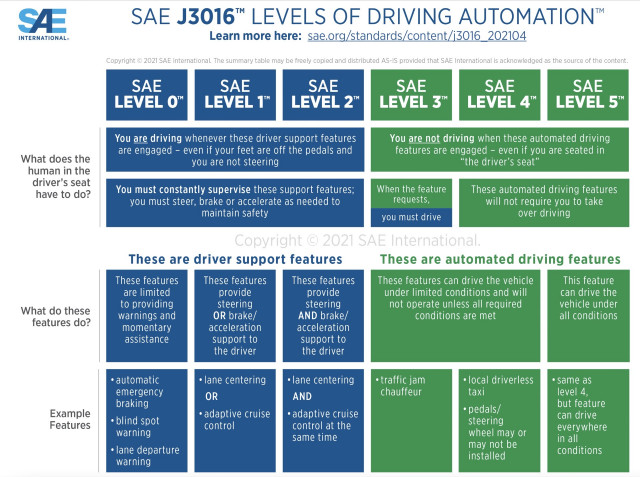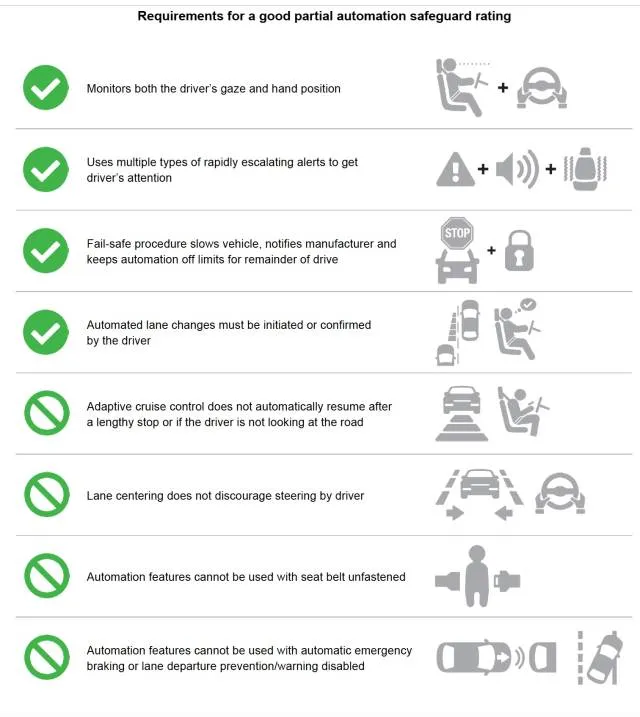Hands-free driving systems don’t do enough to keep drivers paying attention and roadways safe, according to a new study released Tuesday by the Insurance Institute for Highway Safety.
The IIHS tested 14 semiautonomous driving systems across nine brands, ranging from GM’s Super Cruise to Ford’s BlueCruise and Tesla’s Autopilot, and found that 11 of them earned a rating of “Poor.”
“Most of them don’t include adequate measures to prevent misuse and keep drivers from losing focus on what’s happening on the road,” IIHS President David Harkey said in a statement, adding that branded misnomers such as Autopilot can confuse drivers into thinking the systems are more capable than they are in testing and reality.


IIHS ADAS ratings for 14 semiautonomous systems
There are no self-driving cars on sale today, categorized as Level 5 autonomy by the SAE, meaning such a vehicle could go from a starting point to a destination without driver intervention or oversight. The most sophisticated systems employed in mass produced cars are Level 2, or driver-assist systems that combine adaptive cruise control and active lane control to enable limited hands-free driving on mapped highways. Some automakers market their systems as Level 3, such as Mercedes-Benz’ new Drive Pilot system being rolled out in California and Nevada.
Partial automation has been touted as a luxury feature to ease fatigue during roadtrips, but the latest battery of tests by the IIHS found little correlation between semi-autonomy and safety.


SAE levels of driving automation, from none to fully self-driving
“Some drivers may feel that partial automation makes long drives easier, but there is little evidence it makes driving safer,” Harkey said. “As many high-profile crashes have illustrated, it can introduce new risks when systems lack the appropriate safeguards.”
The IIHS launched a new set of tests and criteria to measure the efficacy of driver-assist systems, similar to how it updates its crash-test criteria as more makes and models meet the qualifications for a Top Safety Pick award. The TSP and more robust Top Safety Pick+ awards are deemed the most rigorous and most esteemed safety criteria in the industry.
For 2024, the nonprofit safety agency funded by the insurance industry ratcheted up the safety criteria for a Top Safety Pick for the third year in a row. Last year, the IIHS changed the side-impact test from a strike barrier weighing 3,300 pounds, as it had been since 2003, to a 4,180-pound barrier traveling at higher speeds to reflect the change in vehicle size and driver behavior in the past 20 years. The average weight of an SUV has increased 1,000 pounds to 4,600 pounds in the two decades since the test’s last update, according to the IIHS.
Unlike the NHTSA’s NCAP safety protocol, the IIHS also tests for advanced driver-assist systems (ADAS). To address a spike in pedestrian fatalities, last year the IIHS started testing how ADAS systems can mitigate or avoid collisions with pedestrians in separate daytime and nighttime tests.
Alongside Consumer Reports and the NHTSA, the IIHS was instrumental in encouraging automakers to voluntarily commit to equip more than 95% of new passenger vehicles with standard automatic emergency braking (AEB). Started in 2016 and realized late in 2023, cars with automatic emergency braking and forward collision warnings would prevent 42,000 crashes and 20,000 injuries by 2025, based on crash-test data compiled by governmental agencies and assessed by the IIHS.
The latest tests and subsequent ratings aim to increase safeguards and reduce misuse of semiautonomous systems. The tests measure the five following test categories:
- Driver monitoring to make sure the driver’s head or eyes are directed at the road and whether their hands are holding something the shape of a cell phone instead of on the steering wheel
- An attention reminder that makes an audible and visual warning within 10 seconds of a driver not paying attention
- Emergency procedures within 35 seconds of a driver not responding to warnings, including sending out SOS signals, slowing the car to a stop, and preventing the driver from restarting the system
- Drive involvement such as when adaptive cruise control brings the car to a stop, it should not restart until the driver is looking at the road, as well as other safeguards from a stop
- Essential safety features such as seat belts must be engaged before ADAS can be used.
It’s no wonder most of the current systems on the market failed to meet such strict conditions. Only the Lexus Teammate with Advanced Drive, which is one of the most conservative systems we’ve tested, earned an “Acceptable” rating. Super Cruise and Nissan’s ProPilot were the only two to earn “Marginal” ratings, while the other 11 systems rated “Poor.”
It remains to be seen how or if these ratings will be used in future TSP awards.


IIHS requirements for
